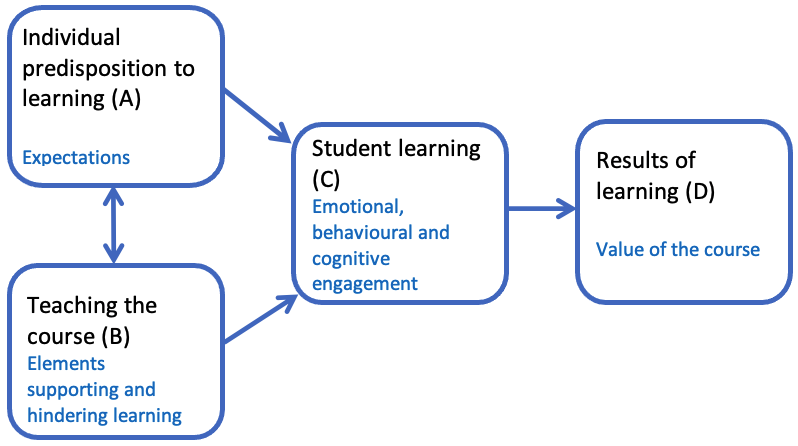
Instruction for the interpretation of the course feedback questionnaire for teachers
Foundations for the course feedback questionnaire
In recent decades, learning has been interpreted through the constructivist approach. According to this approach, learners are active constructors of knowledge; therefore, the activity of the learner has an essential role in learning, and the lecturer is in the role of a supervisor and supporter (,). Studies have shown that students’ learning results and progress at the university are related to their engagement in learning; the more the students are engaged in learning, the better their learning results (,). In addition, it has been found that the more possibilities the learners have for action (e.g., to discuss what is learned, to solve problems, etc.), the more engaged they are. Thus, the lecturer’s main aim is to shape a learning environment that facilitates and supports learning, to plan the objectives and learning outcomes, to choose the methods of teaching and assessment, and the assignments and to offer opportunities for meaningful discussion, considering the characteristics of the learner and the objectives of the curriculum (). Researchers of learners’ motivation (,) have also said that students are motivated to learn
- if they can make choices and decisions, e.g., which problem they would like to solve or which theme they research (the need for autonomy);
- if they have the knowledge and skills for solving the problems and they feel that they develop (the need for competence);
- if they can discuss the material learned and they feel engaged in the study group (the need for engagement).
Considering the above, Lawson & Lawson’s model of active learning or engagement (2013) was used as the theoretical basis for the course feedback questionnaire. According to this, learning results depend on the level of learners’ engagement in the learning process. Learners’ engagement, in its turn, is shaped as a result of their individual expectations and teaching of the course (see Figure).

Figure. Active learning model accommodated to the context of the course.
Considering the principles described above, a four-part questionnaire on learning and teaching of courses was compiled and used for collecting feedback to courses taught in the spring semester of 2019. An analysis of the gathered data showed that when learners respond to the questions at the end of the course, they do not distinguish between their readiness to commit to learning while registering to the course and being engaged during the studies. This is why the model was adjusted, and from the autumn semester of 2019, the questionnaire consists of three parts: 1) teaching of the course; 2) student learning and 3) results of learning.


